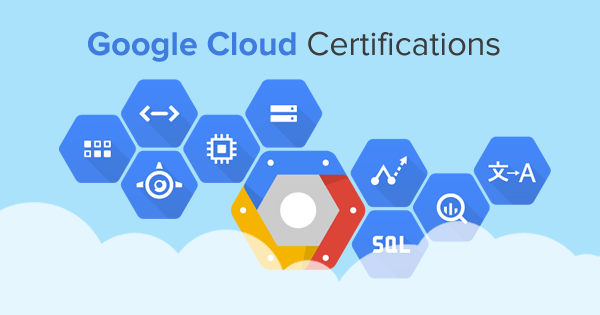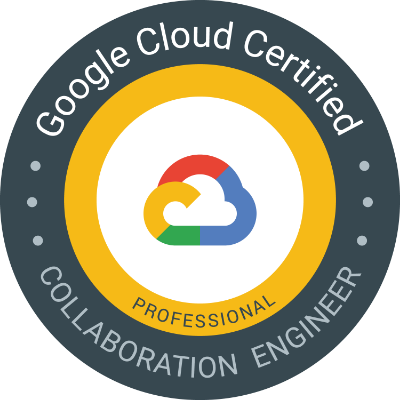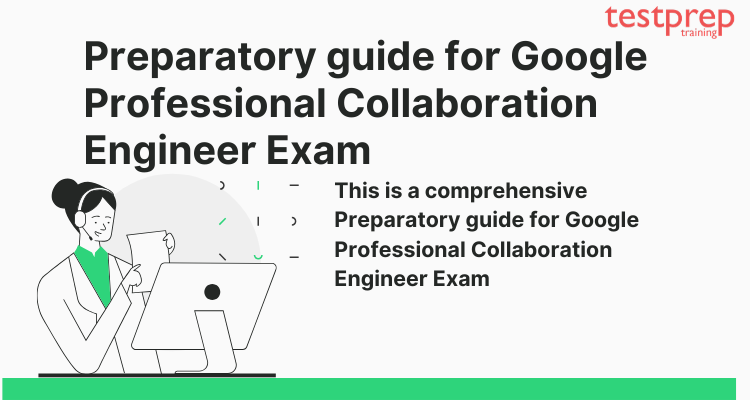A candidate taking Google Professional Collaboration Engineer (Gcp) exam is someone who can turn business goals into practical setups, rules, and safety measures concerning users, content, and connections. Cloud technology is a big success in the IT industry, and many businesses use it because it offers many advantages. This means there’s a growing demand for experts like cloud developers and architects in this field. Moreover, getting certifications has become a popular trend in the IT industry and is highly valued.

Cracking the certifications like Professional Collaboration Engineer Exam can be challenging enough. But the exam is worth taking as this gives the candidate global recognition in this field along with the access to huge community. Survival of fittest has become the policy to rule the corporate sector. You have to be excellent in depicting your skills in order to maintain your position. Now, the certifications, in this situation helps you to get promotions and show your commitment towards work. Also, we all know, a certified professional is valued way more than a normal employee.
This article will provide you with the all the details regarding the Google Professional Collaboration Engineer Exam along with the available preparatory resources. Stay tuned till the end to collect all the information. Let us get underway!
What is Google Professional Collaboration Engineer Exam?
A Google Cloud Professional Collaboration Engineer takes business goals and turns them into real setups, rules, and security measures for things like users, content, and connecting different parts together. These engineers use their knowledge of how their organization manages emails and identities to make sure communication and data sharing is both efficient and safe.

Operating with an engineering and solutions mindset, they use tools, programming languages, and APIs to automate workflows. They look for opportunities to educate end users and increase operational efficiency while advocating for G Suite and the Google toolset.
The Professional Collaboration Engineer Certification assesses your ability to:
- firstly, Plan and implement G Suite authorization and access
- secondly, Manage user, resource, and Team Drive lifecycles
- thirdly, Manage mail
- subsequently, Control and configure G Suite services
- furthermore, Configure and manage endpoint access
- in addition, Monitor organizational operations
- lastly, Advance G Suite adoption and collaboration
Now let us move forth to the exam overview, for collecting the details of the exam.
Exam overview
Getting each and every detail of the exam is deemed to be one good step towards preparation. This exam consists of almost 50 questions that have to be answered in 2 hours. The cost of taking the exam is $200 plus taxes wherever applicable. Google Professional Collaboration Engineer Exam Questions are in Multiple choice and multiple select format. The exam doesn’t require any specific qualifications, but Google suggests having at least 3 years of experience in the industry, with at least 1 year of experience in G Suite administration.
The Google Professional Collaboration Engineer Exam is available in English and Japanese language. You can register for the exam online by creating a google Webassessor account.
Here is a table with the combined information:
| Name of the exam | Google Professional Collaboration Engineer Exam |
| Time allowed | 2 hours |
| Cost of the exam | $200 |
| Experience recommended | 3+ years of industry experience including 1+ year G Suite administration experience |
| Languages available | English and Japanese |
| Registration platform | google Webassessor account |
| Types of questions asked | Multiple choice and multiple select questions |
These were all the details related to the exam. Let us now look at the syllabus for Google Professional Collaboration Engineer Exam in detail.
Professional Collaboration Engineer Syllabus
The Google Professional Collaboration Engineer Exam will test you on the following basis:
1. Planning and implementing G Suite authorization and access
Firstly, Implementing authorization policies. Considerations include:
- Basic user security controls (e.g., password length enforcement and 2-Step verification)
- Security aspects of identity, perimeter security, and data protection
Secondly, Using G Suite as a service provider. Considerations include:
- Configuring third-party SSO for G Suite
- Integrating with third party for provisioning
Subsequently, Using G Suite as an identity provider. Considerations include:
- Configuring and managing SSO for common third-party applications
- Configuring and managing provisioning
Lastly, Managing access to third-party applications and sites. Activities include:
- Granting API access to applications that need access
- Revoking third-party OAuth access
- Removing connected applications and sites
2. Managing user, resource, and Team Drive lifecycles
Firstly, Managing users. Considerations include:
- Adding users (e.g., individual, bulk, automated)
- Removing users (e.g., suspending, deleting, recovering)
- Transferring user data from one user to another
- Editing user attributes (e.g., renaming, passwords, aliases)
- Creating administrative roles (e.g., default roles, custom roles)
- Managing user licenses (e.g., licensing models, G Suite SKUs)
- Troubleshooting conflicting accounts
- Implications of current G Suite APIs to development efforts
- Using Google Apps Script to automate tasks
Secondly, Synchronizing data in your Google domain with your Microsoft® Active Directory® or LDAP server. Considerations include:
- Integrating LDAP with G Suite
- Configuring and troubleshooting GSPS and GCDS
- Implications of current G Suite APIs to development efforts
- Using Apps Script to automate tasks
Thirdly, Managing organizational structure. Considerations include:
- Designing efficient organizational unity (OU) structure based on business needs
- Assigning users to relevant OUs
- Modifying OU policies
- Implications of current G Suite APIs to development efforts
- Using Apps Script to automate tasks
- Managing and verifying domains
- Using Google Takeout to export data
- Managing company profile settings
Subsequently, Managing groups. Considerations include:
- Configuring Google Groups
- Adding users to groups
- Implications of current G Suite APIs to development efforts
- Using Apps Script to automate tasks
Furthermore, Managing contacts. Considerations include:
- Creating contacts
- Sharing contacts
- Implications of current G Suite APIs to development efforts
- Using Apps Script to automate tasks
3. Managing mail
Firstly, Managing mail-related DNS settings. Activities include managing:
- The domain MX records
- domain SPF records
- domain DKIM records
- the domain DMARC records
Secondly, Diagnosing and resolving mail routing issues. Considerations include:
- Analyzing mail flow
- Analyzing email headers
- Email log search
- Disparate email services
- Using G Suite Toolbox
Thirdly, Configuring and managing security, compliance, and spam rules. Activities include configuring and managing:
- attachment compliance
- blocked senders
- email whitelist
- objectionable content
- phishing settings
- spam settings
- admin quarantine
- secure transport compliance
- safety settings
In addition, Configuring mail routing rules. Considerations include configuring:
- split and dual delivery scenarios
- Implications of integrating third-party mail services
- routing rules
- recipient map
- non-Gmail mailbox
- hosts
Finally, Configuring general mail settings. Activities include:
- the Configuring append footer setting
- Configuring forwarding
- The Configuring of SMTP relay
- Enabling email delegation for an OU
- Disabling IMAP and POP
- Managing Gmail archives
4. Controlling and configuring G Suite services:
Firstly, Administering G Suite Services. Activities include:
- Managing rollout of new Google functionality to end users
- Troubleshooting G Suite services (e.g., performance issues for services suite, G Suite apps for OUs)
- Configuring services
Secondly, Configuring and managing G Suite core apps. Considerations include:
- Contacts/Directory (e.g., ability to make updates to Directory services or contact support or contacts sharing settings)
- Calendar (e.g., Calendar sharing settings and delegations, Calendar resource management, Calendar invitations sent to Groups, troubleshooting calendar interoperability)
- Drive/Team Drive (e.g., storage limitations in Basic plan)
- Groups (e.g., creating and editing groups, banning group members from posting to the group)
- Chat/Meet (e.g., disabling Hangouts voice calls for organization, designing video conferencing integration of Hangouts with different end points, disabling bot access on new Hangouts chat)
- Sites (e.g., usage and implementation)
subsequently, Managing services integrations. Activities include:
- Integrating third-party marketplace apps to specific OUs in G Suite
- Evaluating Marketplace and Connected app landscape
- Managing private add-ons, chrome extensions, Appmaker Apps, etc.
- Adding SP to Cloud Identity
Finally, Implementing automation. Considerations include:
- API permissions
- Able to interact with APIs and lightweight scripting
- Apps Script and App Maker capabilities
- Service Accounts
5. Configuring and managing content access
Firstly, Configuring and managing Vault. Activities include:
- Setting retention rules (e.g., setting retention rules, placing legal holds, searching your domain’s data by user account, OU, date, or keyword, exporting data for additional processing and review, auditing reports)
- Holding and exporting data
- Running Vault audit reports
Secondly, Configuring and managing Drive and Team Drive. Activities include:
- Configuring sharing settings (e.g., updating sharing settings to external domains, controlling file access with Information Rights Management)
- Managing Drive folder structure (e.g., using Google Drive native file formats, recommending Google Drive and Team Drive file structures)
In addition, Ensuring compliance with regulatory requirements. Activities include:
- Scanning email with Data Loss Prevention (DLP)
- Managing content compliance rules
Furthermore, Implementing and monitoring data security. Activities include:
- Configuring security and data region
- Monitoring security health check
- Configuring security settings
- Creating security records
- Designing security integration and addressing objections.
Lastly, Managing third-party applications and access. Activities include:
- Backing up solutions of G Suite data for compliance
- Whitelisting OAuth apps
6. Configuring and managing endpoint access
Firstly, Configuring mobile devices. Considerations include:
- Company-owned vs. personal devices
- Configuring personal device settings (e.g., password, Android, iOS, advanced, device approvals, app management, insights)
Secondly, Provisioning, deprovisioning, and enabling Chrome devices
Thirdly, Managing Google meeting room hardware (e.g., provisioning, deprovisioning, hanging up, calling, rebooting)
Furthermore, Managing Chrome apps, extensions, and Android apps
Finally, Configuring network settings (e.g., Wi-Fi, Ethernet, VPN, certificates, and general)
7. Monitoring organizational operations
Firstly, setting up and using reports (e.g., creating usage reports, measuring adoption and satisfaction)
Secondly, setting up and using audits (e.g., auditing document sharing, auditing Gmail and drive, auditing users)
Also, interpreting report and audit data and taking appropriate action. Examples include:
- Troubleshooting and escalating support issues to Google Partner support or Google Engineering
- Troubleshooting error logs
- Identifying data leakage scenarios and implementing ways to prevent
- Streaming audit data to BigQuery
Finally, managing alerts (e.g., suspicious logging activity, apps outages, TLS failure, user deleted)
8. Advancing G Suite adoption and collaboration
Firstly, Building business solutions and processes. Examples include:
- Creating simple workflow using App Maker
- Creating simple processes using Apps Script
- Also, Creating team project sites
Secondly, Staying up-to-date with G Suite. Examples include:
- Using Google and partner support channels
- Accessing and interpreting G Suite roadmap
- Staying aware of new features and functionality in G Suite
These were the syllabus details of Google Professional Collaboration Engineer Exam. Let us now look at some of the preparatory resources available for the exam.
Preparatory resources
How well you do in the exam depends on how well you prepare. To excel, you must pick the right study materials that match your learning style and knowledge level. There are plenty of resources to help you get ready for the Google Professional Collaboration Engineer Exam. Let’s explore some of these resources mentioned in the Professional Collaboration Engineer Study Guide.
Resource 1: the official site visit
firstly, Official site of the exam provides information about various technicalities of the exam. The official site also mentions various resources such as Professional Collaboration Engineer Practice Exam and G Suite Administration Specialization. Google also provide platform for the hands- on practice for the exam. This exam is designed to test technical skills related to the job role. Apart from knowing what a G Suite administrator does regularly, you can enhance your knowledge and skills by using the hands-on labs provided on Qwiklabs to learn more about G Suite integrations.
Resource 2: books
secondly, You can refer to any book that you are familiar with and that suits best to your level of understanding. Also, you can refer the books prescribed by google. Visiting libraries and also doing research on the best books that are available in the market will help in improving the quality of your preparation to a greater extend. Some of the books that you can refer to and those are easily available are listed below:
firstly, Official Google Cloud Certified Associate Cloud Engineer Study Guide
also, Professional Cloud Architect – Google Cloud Certification Guide: A handy guide to designing, developing, and managing enterprise-grade GCP
in addition, Google Cloud Platform for Data Engineering: Learn fundamental to advanced data engineering concepts and techniques using 30+ real-world use
lastly, Hands-on G Suite for Administrators
Resource 3: practice papers and test series
Thirdly, Professional Collaboration Engineer Practice Exam and test series are a way to determine the level of your preparation. Additionally, these practice exercises will pinpoint the areas where you’re not as strong in your preparation and reduce simple errors. Using this approach to practice for the exam helps you find your weak spots and lowers the likelihood of making mistakes on the actual exam day. Moreover, numerous trustworthy sources offer high-quality study materials, including many online educational websites. Try a free practice test now!
Resource 4: online trainings and instructor led courses
lastly, You can opt for the Google Professional Collaboration Engineer Training and instructor led courses for preparation. They are interactive enough and provide a space to discuss about the things properly. They also provide relevant study material like notes and recorded lectures for the purpose of making things clear properly.
So, these were the some of numerous resources available to us. You can choose any of them or can go for any other as per your suitability.
Conclusion
In the end, the Google Professional Collaboration Engineer Exam is worth a try. If you clear the exam you will get a way to get yourself recognized globally. This exam is also step forward to getting the dream job. With the right set of resources you will surely crack the exam.
All the best.


